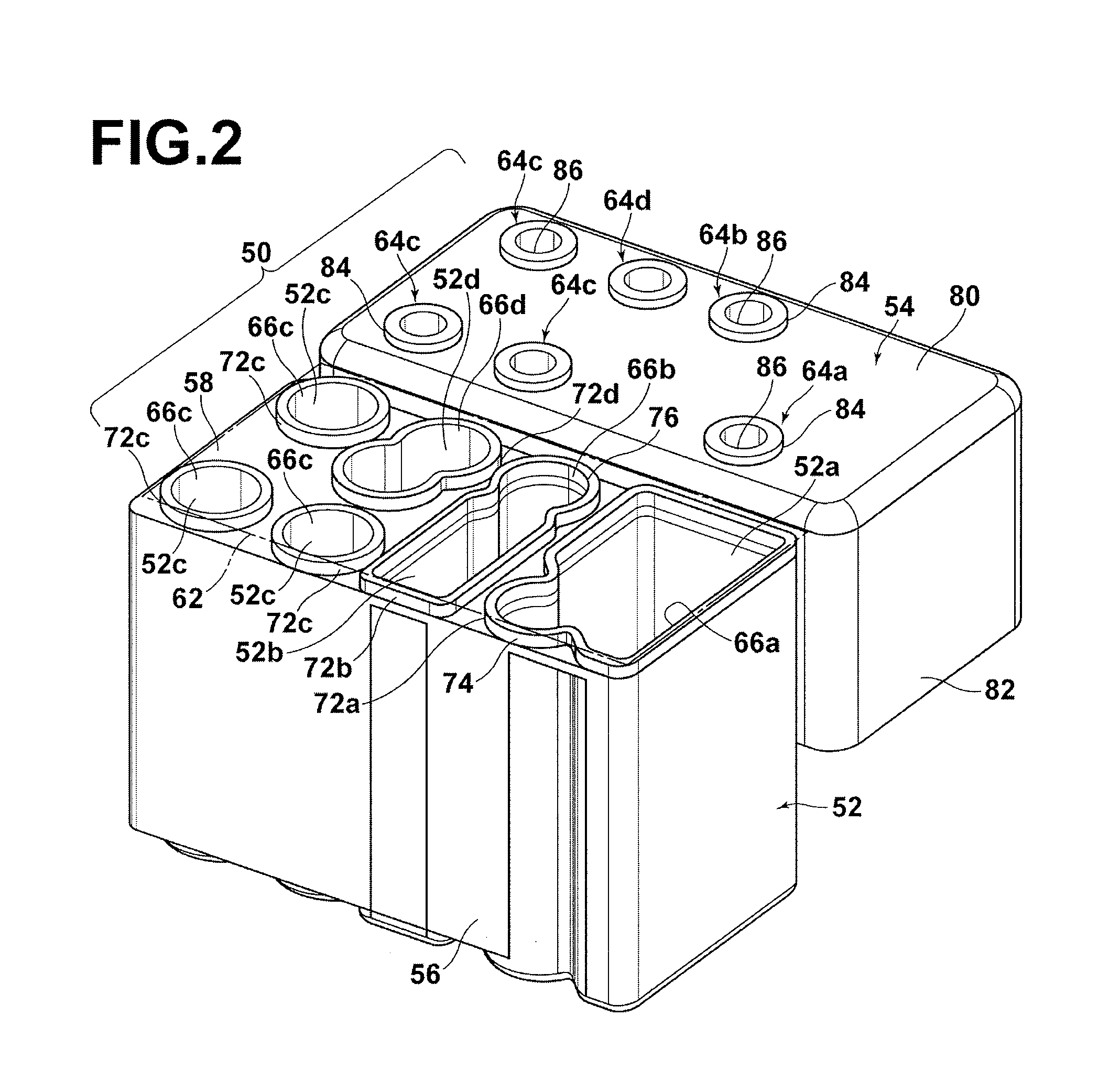Reagent container
a technology for reagents and containers, applied in the field of reagent containers, can solve the problems of time and effort, difficult to closely pack a plurality of reagent holding sections in one reagent container, and difficult to downsize the reagent container, so as to prevent measurement results and reduce the amount of for
- Summary
- Abstract
- Description
- Claims
- Application Information
AI Technical Summary
Benefits of technology
Problems solved by technology
Method used
Image
Examples
second embodiment
[0078]Next, the features of the second embodiment will be further described with reference also to FIG. 5. FIG. 5 is a perspective view in which reagent container 300 is disposed in a reagent container mounting area 350 of an analyzing device (not shown). Container body 302 of reagent container 300 has two upward engaging recesses 357 formed on outer circumferential wall 356. Lid 304 has downward engaging protrusions (engaging section) 360 formed at positions corresponding to engaging recesses 357 to engage with and held by engaging recesses 357. This allows integrated reagent container 300 to be formed by pressing lid 304 onto container body 302 and causing them to engage with each other. Horizontally protruding tabs (positioning section) 362 and 363 (FIG. 4A) are formed on the wall surfaces of cover wall 382 of lid 304 oppositely separated from each other in a longitudinal direction of cover wall 382. Tab 362 has a hole 362a formed in the center (FIG. 4A).
[0079]In the mean time, r...
first embodiment
[0082]As in the first embodiment, when using lid 54′, lid 54′ is put on container body 52′ from above and simply pressed downward. Then, reagent container 50′ can be carried around by pinching the handle so that reagent container 50′ may be mounted easily in an analyzing device or the like. When lid 54′ is provided with handle 60 as in the present modification, rectangular engaging opening (engaging section) 70a is provided in cover wall 82′ and engaging protrusion 70b that makes concavo-convex engagement with engaging opening 70a is provided on container body 52′ so that container body 52′ is securely held by lid 54′. A pair of engaging opening 70a and engaging protrusion 70b is provided at each of opposite positions of cover wall 82′. But the shapes and attaching positions of engaging opening 70a and engaging protrusion 70b are not limited to those described in the first modification, and modifications and changes may be made. It should also be appreciated that the shape, size (le...
third embodiment
[0084]Next, reagent container 100 according to the present invention will be described with reference to FIGS. 7 and 8. FIG. 7 is an overall perspective view of reagent container 100. FIG. 8 is a perspective view of container body 102 of reagent container 100. Container body 102 has a fan shape in planar view and a rectangular shape in side view. Such shape is appropriate for mounting reagent containers 100 in an analyzing device side by side in a circle with the narrower portion of the fan shape of each reagent container 100 being oriented on the inner side. For the sake of convenience for explanation, hereinafter, the narrower portion is referred to as “first end” and the arc shaped wider side is referred to as “second end”.
[0085]As shown in FIG. 8, container body 102 includes a plurality of holding sections 152a, 152b, 152c, and 152d having openings (opening sections) 166 (166a, 166b, 166c, and 166d) in top wall 158. Holding sections 152a, 152b, 152c, and 152d are integrally form...
PUM
 Login to View More
Login to View More Abstract
Description
Claims
Application Information
 Login to View More
Login to View More - R&D
- Intellectual Property
- Life Sciences
- Materials
- Tech Scout
- Unparalleled Data Quality
- Higher Quality Content
- 60% Fewer Hallucinations
Browse by: Latest US Patents, China's latest patents, Technical Efficacy Thesaurus, Application Domain, Technology Topic, Popular Technical Reports.
© 2025 PatSnap. All rights reserved.Legal|Privacy policy|Modern Slavery Act Transparency Statement|Sitemap|About US| Contact US: help@patsnap.com



